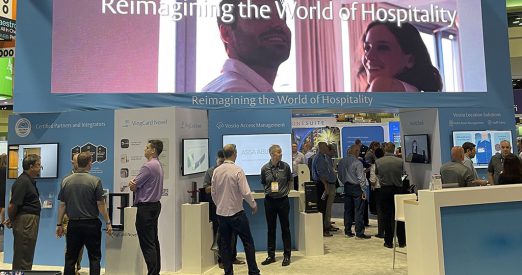
Why Hotel AP Is Different
by The Ottimate Editorial Team
Hotel accounts payable (AP) is a complex operation to manage. As with any process that takes place in a business with multiple locations, hundreds of staff members, difficult-to-predict revenue, and more than one set of books under one roof — things can get challenging. Luckily, hotel AP automation is here to help.
Hotels purchase goods and services from one of the most diverse sets of vendors imaginable: everything from food distributors to landscaping professionals, from travel to live acts. Keeping it all organized requires technology built to handle the rigors of hospitality. It requires hotel AP automation.
Golder Hospitality, one of Ottimate’s hotel clients, said it best: “We’re a unique industry. Whenever we’re looking at vendors, we need it to be a vendor that understands the space, because we’re an industry that doesn’t shut down.”
What exactly makes hotel AP so out of the ordinary — and hotel AP automation so tailored a solution? Here are four reasons.
Hotels Have Many Businesses Under One Roof
Diverse lines of business sit right next to each other inside a hotel. Even within one location, there might be separate entities acting as, functionally, their own businesses: F&B outlets, entertainment venues, event spaces, and more.
It’s not uncommon for each of those entities to have their own P&L. This requires a central accounting office to have some kind of flexibility in their workflow, so that invoices remain organized correctly while still being able to be arranged in an intelligible, high-level summary.
The Hotel AP Solution
The automation that processes hotel invoices needs to be set up to support multiple entities within a single, unified account. And it needs to make it easy and automated to assign each invoice — or set of bulk invoices — to the right entity.
Simply by uploading invoices to the system and selecting the destination entity, the system is able to automatically map each line item to the right GL code (and even that department’s specific GL code) but also tag each invoice with the appropriate Department.
In other words, part of the upload process involves segregating the gift shop invoice from the F&B invoice — thus allowing their P&Ls to remain separate — while all living in the same account. This system makes hotel AP automation easier to use and a better source for reporting.

Property-Level Staff Are Highly Involved With Hotel AP
A common hotel AP workflow requires employees at the properties to take on an important aspect of processing the company’s invoices. Usually GMs or other property-level staff are responsible for getting invoices to the company’s central AP team, or even into the company’s accounting software directly.
This process can go sideways quickly. GMs — when they find the time to sit down and do this — are not invoice experts. They’ll enter typos, scan the wrong side of the page, code line items incorrectly, you name it. To be fair, this isn’t their job. Actually, processing invoices keeps them from their job: creating hospitality for guests and ensuring smooth operations on the ground.
The Hotel AP Solution
Automated AP solutions for hotels help property-level staff spend as little time as possible entering and coding invoices. A hotel-grade upload & ingestion process means that tools like AI-based transcription, the aforementioned GL coding, and advanced approval routing take almost all of that invoice work off GMs’ plates and give teams much better visibility.
Hotels Have Properties With Different Tax Jurisdictions
Managing properties in different states doesn’t just mean a high T&E budget for the company executives. It also means that accounting for differing regulations — and tax rules especially — lands inconveniently on the AP team.
Keeping track of how a patchwork of regulations affects purchasing is tough enough. (For example, hotel AP teams need to understand how different liquor taxes affect F&B budgets.) But there’s an additional challenge when the AP team needs to allocate one charge to multiple locations. Each one, of course, with unique tax rules.
The Hotel AP Solution
AP automation used by a multi-state business needs to include a function for allocating invoices and individual purchases among locations with different parameters. The system should make it easy to apply these location splits in bulk, as well.
With an automated way to charge branches different amounts, it becomes easy to charge hotel properties different amounts for commonly split purchases.
Hotel Tech Stacks Are Complex
To manage complex and sometimes unrelated operations, hotels use many pieces of intertwining technology. Some of these systems are seamlessly connected to one another. More often, there are big holes. Plenty of operators have no easy way to connect their property management system with their F&B reservation system, for example, meaning they don’t quite know which guests stayed on the property to eat. It all depends on the operator and the technology they use.
AP workflows, too, can easily get lost in a hotel’s thicket of back office software. Paying an on-site restaurant’s vendors, for example, might not use the same process as paying corporate-level accounts. Hotel AP teams need to keep these accounts and workflows separate, even if they still want a uniform way to schedule payments and gather data for reporting purposes.

The Hotel AP Solution
Within enterprise-grade tech stacks, hotel AP software acts as middleware: a piece of technology that optimizes one piece of a large workflow and plugs into the rest of the tech stack.
The keys to this connectivity are integrations. They can take the form of API connections, which connect two pieces of software on the back end, or customizable CSV exports, which while more manual, allows each system to ingest data in its native format.
Integrations permit easy data import and export and connect the software reliably. This way, hotels can plug in the best software for every piece of their invoice and bill pay process, while keeping all their systems in sync with the same real-time data.
Understanding “An Industry That Doesn’t Shut Down”
Accounts payable automation does more than save time for the AP team. It also empowers a broader organizational alignment: it becomes easy to keep different sets of books under one roof, it allows technology to communicate with each other, and gives property-level staff critical time back to focus on their jobs. (And relieves AP staff from having to worry about how accurately GMs will enter invoices.)
Ottimate is just such a hospitality-focused AP solution. We were created to serve the needs of hospitality, and with customers across the hotel and restaurant industry, we’re freeing up schedules and connecting together far-flung properties every day.
To see how Ottimate could help your hotel’s invoice and bill pay workflows, request a demo now.
Stay up to date on the latest news in AP automation and finance
Related

